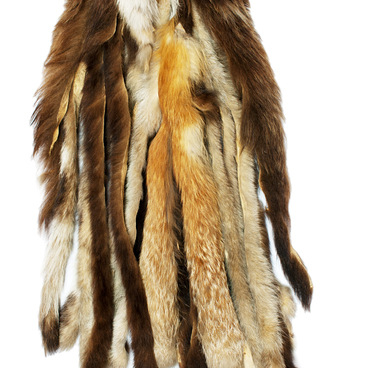The Udege people, like all the indigenous peoples of the Amur region, were animists (they believed in the existence of spirits) and practiced shamanism. The costume of the Udege shaman consisted of a robe, skirt, apron, girdle, headdress, kneepads and shoes. A tambourine, mallet, masks, staff and mirrors were his essential attributes. The belt was an additional element, which was necessary during a long kamlanie ritual. It was fastened to the girdle.
Some researchers call this shamanic accessory a belt leash. The belt on display was given to the museum by Vladimir Arsenyev. He found it in August 1911 on the Tabokhe River. The belt belonged to the Udege people, it was woven by a fine plait of grass and colored ribbons. Such an accessory was often made in the form of a snake, and, in that case, it was made of elk skin.
One end of the belt was attached to a small wooden staff. Its hilt was painted in alternating dark and light stripes. The upper part of the staff looked like a human head with a broad, short sword-knife on the top. The lower end was fitted with bird feathers. It was believed that they could help the shaman to fly up into the sky.
During the kamlanie ritual, one end of the belt was tied around the shaman’s waist. The other end was held by several people (the records of Vladimir Arsenyev indicated that there were supposed to be eight of them), so that the shaman would not fly away and stay in the other world. All Amur shamans used such a belt.
The belt could be up to 15 meters long, and sometimes a short three-meter belt could be a good fit. Traditionally, the belt was used during the rite of kasa wake — the transportation of the souls of the dead to the afterlife. The Udege people believed that this world was tiered and consisted of three stages: the lower (kengma oeni), the middle (dokini oeni) and the upper (buniga).
The Udege people could
not describe the lower stage. They visualized Dokini oeni as the world of
robber cannibals, who, when visiting the earthly world, become invisible evil
spirits and hunt people. They believed that Buniga was inhabited by the souls
of dead people. Their way of life was the same as that of the people of the
earth. The difference was that it was the other way around: if it was summer on
earth, it was winter in Buniga.



